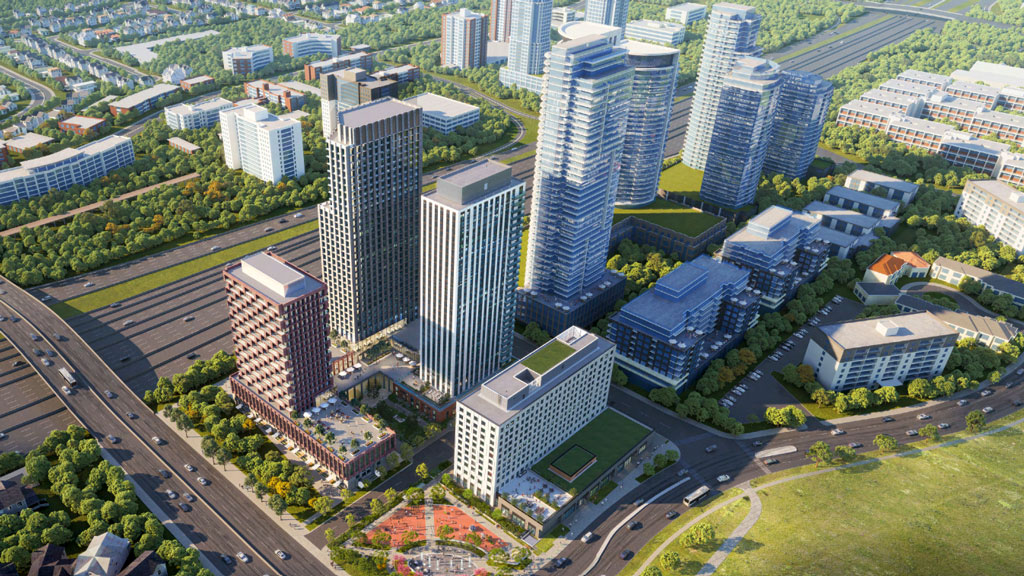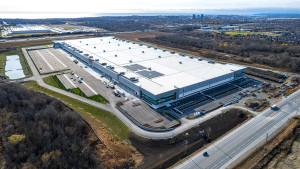Construction has begun on Valhalla Village, a new housing development that addresses Toronto’s need for affordable housing and sustainable infrastructure in a unique way.
Developer KingSett Capital partnered with Geosource Energy, which specializes in geothermal heating and cooling systems, for the project located at Bloor and the East Mall. The first phase of the program includes two towers, one 10 storeys and the other 29 storeys.
Once complete, it will deliver 172 affordable rental units of the 494 units. It is expected to be completed in 2026.
“It’s the first of many buildings that we hope to develop, either as developer or as equity partners, in a fund strategy that we have to deliver more affordable housing and effect positive change with the housing crisis,” said Jeff Thomas with KingSett Capital. “We raise a fund specific to do just this. As it turns out where we’re most lacking is supply of new units and where the need is most acute is at various levels of affordability beyond market housing. The buildings that we’re building have some component of market housing and then they have some component of affordable housing.”
The project is financed through the federal Rental Construction Financing Initiative (now the Apartment Loan Construction Program) and the City of Toronto’s Open Door Program.
Valhalla Village is set to achieve Zero Carbon Building — Design certification from the Canada Green Building Council.
“Often if you have a geothermal system, because we’re in Canada, the fluctuation of temperatures can be quite drastic so you’ll still need a gas fired boiler to supply your domestic hot water so when you turn on the tap you’ve got hot water available,” said Thomas. “In the case of Valhalla, what makes it so interesting is that the geothermal loop is designed to maintain enough heat so that we don’t need a gas fired boiler for domestic water…A high-quality envelope with the geothermal is what makes this special.”
From the outset of the project, the owners opted for geothermal energy. It aligns with Canada’s 2050 net-zero emissions target. It also qualifies the project for federal loans and municipal incentives to offset upfront costs and support affordable housing.
The 145-borehole geothermal system was designed, constructed and installed by Geosource. It began with drilling holes in the ground that are four-and-a-quarter-inch in diameter.
“At Valhalla we drilled 850 feet,” explained Kate Cheng, VP US Markets and board adviser with Geosource.
“Then we put in a U loop…that goes from the bottom of the hole to the top. Then we fill the voids in the hole. If you imagine an empty hole plus the loop there is a bunch of air between the walls of the hole which is not good. We need to make sure there is a thermal conductor between the outside of the loop and the walls of the hole because that’s what helps with the thermal conductivity in the entire system.”
The hole is then filled with a conductive grout.
“Those loops are generally filled with a thermally conductive fluid, usually water-based fluid that circulates through the system. That fluid is either taking heat on the ground or its being cooled by the ground,” said Cheng.
“That fluid then circulates through the heat exchanger which will either increase the temperature of that fluid or decrease the temperature of that fluid and then blow air through the building to provide the heating and cooling.”
Geothermal heating and cooling systems are one of the key solutions for creating decarbonized and cost-effective housing.
“When you install a geothermal system you’re building yourself a utility that exists in perpetuity,” said Cheng.
“Instead of forever being beholden to your natural gas provider and paying your bill every single month you essentially own your own utility, you pay your bill and at some point that utility generates revenue. As an asset owner it makes sense because the cost of heating and cooling for the building will decrease which is good because its an apartment and they can pass that onto the end users.”
The team is currently working on the design for the second phase which would consist of another two towers and around 600 units.
Follow the author on X/Twitter @DCN_Angela.








Recent Comments
comments for this post are closed